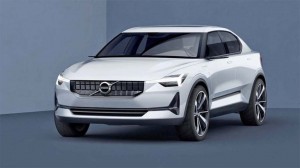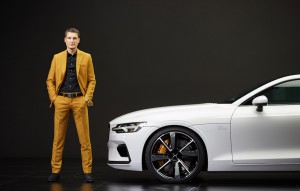Volvo’s performance electric brand is getting ready to charge into the market with two additional models over the next two years, starting with the all-electric Polestar 2 which, a senior official claims, will deliver range of up to 350 miles per charge.
And, in keeping with the mandate of the brand – which traces its roots back to the track – the Polestar 2 “five-door coupe” will deliver around 405 horsepower, according to the brand’s Chief Operating Officer Jonathan Goodman. That figure might actually underplay the potential performance of the all-electric offering, as battery-electric vehicles can deliver incredible off-the-line performance because they punch out maximum torque the moment their motors start spinning.
The Polestar 2 is expected to share the same underlying Compact Modular Architecture, or CMA, as the new Volvo 40-Series line-up. That was an obvious choice considering Volvo itself is planning to offer electrified versions of all future models and the CMA, its newest platform, was designed specifically to allow mounting a large battery pack under the load floor.
(Click Here to check out Polestar’s plug-in supercar, the Polestar 1)
Like the Polestar 1, we can expect the new model to adopt a distinctive, coupe-like shape derived from the Volvo Concept 40.2. You wouldn’t expect brand CEO Thomas Ingenlath, the former head of design at Volvo, to approve something flaky.
“If we’re looking at a market worth 30 million cars within seven years, it isn’t going to be niche, it’s going to be mainstream,” COO Goodman told Britain’s Autocar at the annual Goodwood Festival of Speed. “So you just design a great-looking car—not one with a big blue flash down the side,” he said.
The Polestar 1, you may recall, is a radical machine, using a plug-in hybrid driveline capable of punching out over 600 horsepower by pairing its turbo and supercharged 2.0-liter gas engine with two electric motors.
“We will focus on electric mobility and make it a reality by having something that is not just a dogmatic electric vehicle but something that is desirable to drive,” Ingenlath proclaimed while pulling the wraps off the first model at the Geneva Motor Show last March.
The 2+2 GT also features a lightweight carbon fiber body that not only enhances performance but helps stretch battery range to an estimated 94 miles per charge. (That’s using the European NEDC test cycle, so U.S. numbers should still be an impressive 70 miles, or about a third more than the much more staid Chevrolet Volt PHEV.)
The Polestar 1 won’t come cheap, its roughly $150,000 price tag putting it in BMW i8 territory. Priced somewhere north of $45,000 in the U.S., the Polestar 2 will not only be more affordable, but will be positioned as a direct competitor to the Tesla Model 3, particularly the new performance version that went into production last month.
(Polestar will pump up Volvo’s new S60 performance model. Click Here for more.)
Like Polestar 1, the Volvo sub-brand is expected to turn to the Geneva Motor Show to unveil its first all-electric offering in March 2019. That will come right after the production launch of the plug-in model.
While Polestar has been positioned as something of a niche brand, COO Goodman wants to adopt an inclusive approach to marketing, steering clear of the almost cultish positioning of Tesla.
“I think it’s very dangerous for brands like ours to sit here and ask ‘what’s our type of customer?’”, he told Autoca. “Electric cars will be just as appealing to young executives as they are to retirees. It’s a new market, and purchase intentions will vary. So we’ve got to be a welcoming brand that’s not geeky, cliquey or judgmental.”
Polestar’s product cadence has raised some concerns considering the global auto market is rapidly migrating from sedans and coupes to SUVs and CUVs. The Volvo subsidiary aims to address that by 2020, when it rolls out its first all-electric utility vehicle.
Another question for Polestar is whether it will be able to deliver on time, a challenge that has long plagued Tesla. The California automaker was two years late with its own SUV, the Model X and is only now, more than a year after the launch of the Model 3, beginning to approach its planned production numbers.
It should help that Polestar will have its parent, Volvo, to turn to as it moves its own electric line-up into production.
(Volvo aiming for half its sales to be all electric by 2025. Click Here for the latest.)



